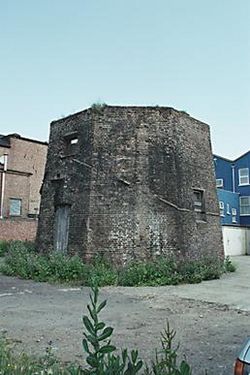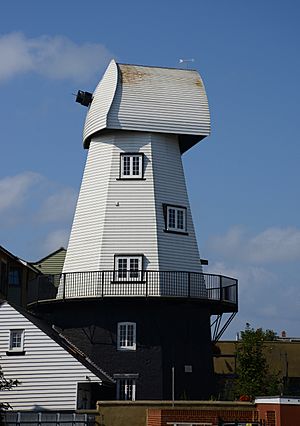Great Mill, Sheerness facts for kids
Quick facts for kids Great Mill, Sheerness |
|
|---|---|

The base in 2003
|
|
| Origin | |
| Mill name | Great Mill Ride's Mill |
| Grid reference | TQ 921 746 |
| Coordinates | 51°26′19.3″N 0°45′45.4″E / 51.438694°N 0.762611°E |
| Year built | 1816 |
| Information | |
| Purpose | Corn mill |
| Type | Smock mill |
| Storeys | Four-storey smock |
| Base storeys | Two-storey base |
| No. of sails | Four |
| Type of sails | Patent sails |
| Winding | Hand winded |
| Auxiliary power | Steam engine 1889 - 1918 |
| No. of pairs of millstones | Three pairs |
| Year lost | 1924 |
| Other information | A new smock has been built on the surviving base to serve as residential accommodation. |
The Great Mill, also known as Ride's Mill, was a special type of smock mill located in Sheerness, Kent, England. It was so important that it was listed as a Grade II historic building. The original mill was taken down in 1924, but its strong brick base remained. Today, a new smock tower has been built on this old base, and it's now used as homes!
Contents
The Mill's Story: Building and Changes
Work on building the Great Mill began in 1813. A millwright named Humphrey from Cranbrook started the project. The ground was tricky, so they needed very deep foundations.
Finishing the Mill
Because of money problems, the mill was left unfinished for a couple of years. Then, Thomas Webb, who owned another mill nearby, bought the unfinished structure. He paid to complete the mill, and it was finally finished in 1816.
Powering the Mill
In 1889, a steam engine was added to help power the mill. This meant the mill could work even when there wasn't enough wind. The mill used wind power until 1905. At that time, its large sails and the stage (a platform around the mill) were removed.
End of an Era
The mill continued to work using its steam engine until 1918. In 1924, the old mill was taken down. However, its strong brick base was left standing. In the 1930s, this base was used to store corn.
A New Life for the Base
In 2006, plans were approved to turn the old mill base into a flat. A new smock tower was built on top of the base, holding another flat. An extension was also added for a third flat. Building started late in 2006. This new replica mill has a stage and sails that are just for show. The top part, called the cap, was lifted onto the tower in late 2007. Sadly, a fire broke out in the new mill tower on January 23, 2008. Luckily, officials later said it was not set on purpose.
What the Great Mill Looked Like
The Great Mill was a four-storey smock mill. It sat on a two-storey brick base. It had a special Kentish-style cap at the top. Four large patent sails were attached to the cap.
How it Worked
The mill was turned by hand to face the wind. It did not have a windmill fantail, which is a small windmill that automatically turns the main mill. There was a platform, or stage, at the second-floor level. The mill used its wind power to turn three pairs of millstones. The steam engine could also power two more pairs of millstones, as well as the ones in the windmill.
Size of the Mill
The mill was about 66 feet (20 meters) tall. The brick walls at the base were very thick, about 22 inches (560 millimeters). The new replica mill has a smock built on a strong steel frame. It also has a Kentish-style cap, just like the original.
People Who Ran the Mill
Here are some of the people who owned and operated the Great Mill over the years:
- Thomas Webb 1816 – 1864
- G Ride & Son 1864 – 1918


